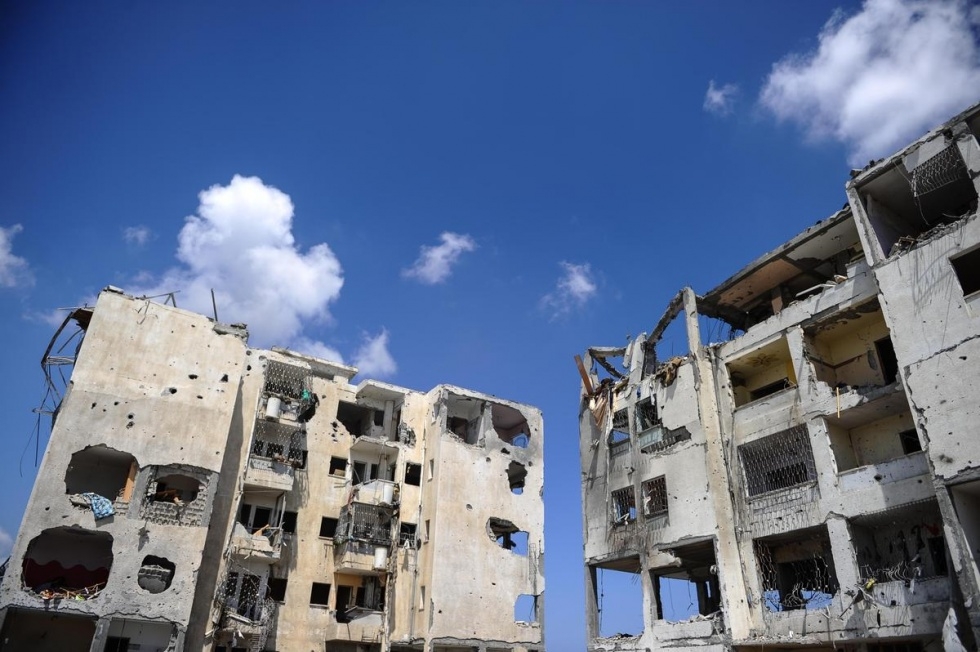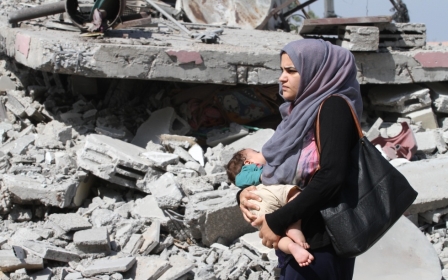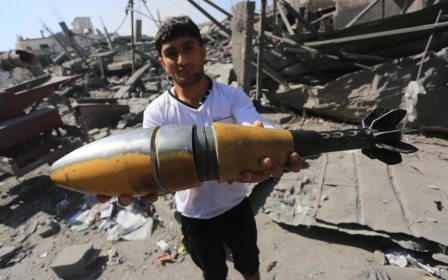Gaza's voice from under the staircase

GAZA CITY - It is no wonder that listeners tuning in to Ahmed Said’s live broadcast are amazed that his radio show is still on air, especially when you consider that the building housing his office and studio has been targeted three times already by Israeli strikes within the past four weeks.
The voice of 30-year-old Said reaches his audience with the help of a group of exhausted, but dedicated, youngsters on Al Shaab Radio (People’s Radio), which brings live coverage of each day’s traumatic events and news from around the Gaza Strip.
Now Said sits under the staircase, with a microphone, mixer, transmitter and the will to resist with words. Said’s real-time interaction with the community can be deeply moving.
A mother calls in from Shejaya, eastern Gaza city. She has only a few minutes battery life left on her cellphone - Israeli missiles targeted the sole power plant in Gaza and there are numerous power outages.
“I appeal to you, my children are scared, Israeli tank shells are hitting my neighbours,” the mother can be heard screaming on the live broadcast. In the background listeners can hear the sounds of tank shells pounding and children screaming.
“I feel powerless myself and realise how much our role as journalists is limited to reflecting people’s true pain, but we can’t rescue the people from their suffering,” said Said, as he clears microphone during break.
But Said’s job goes beyond journalism now, as he opens the airwaves and directs the messages to the International Red Cross Committee officials to intervene and rescue families hit by Israeli air strikes.
As a concerned father of two children, he says he can visualise his own children screaming when he hears other people’s children suffering.
Under the stairs lie cellphone chargers, a computer, and some spare clothes. The youth who work with Said are familiar with his commitment to serious journalism. He could just stay home and say it’s unsafe to show up. But he still comes. His rationale? “Nothing compels me to do this, except the urgency of getting the people’s calls for help, heard.”
In general, all Palestinians speculate about the Israeli mindset and strategy, and, over the years, Said has developed his own deeper analytical sense of how the Israeli government thinks. This insight has brought other media channels, including Al Jazeera and other Arab stations, to approach him for his viewpoints and analysis.
“I believe this is a national message which I have to transmit as a journalist, it is a price I feel I must pay,” said Said when talking about such work.
Sometimes, this price could be the loss of one’s own life, like the tens of reporters killed and injured by Israeli troops. When asked if he is scared broadcasting under the staircase, Said said he was more frightened when phone calls came from his family after they heard him announce Israel’s bombardment of the tower where he and his radio colleagues are located. Said said that women taking shelter under the stairs, in Shujaya, have been hit by Israeli missiles.
“I fear a random tank shell could harm us more than a deliberate targeting of our building as journalists,” he said.
Mahmoud Elyan, the 29-year-old executive director for Al Shaab Radio, works all night long - at 2am he is organising shift changes and checking on his 25 reporters around the Gaza Strip. The decision to go under the staircase was for the safety of his staff members. Israel has special bomb bunkers to protect its citizens, but this is just a makeshift shelter.
“We felt that the Israeli cannon shells were reaching far behind and around us, so our building was a possible target,” he said.
Elyan’s decision to broadcast from under the stairs proved to be wise, as an Israeli missile hit his building once more in the past week, damaging the two floors below them and some floors above.
A uniting force
Al Shaab Radio began broadcasting in 2006, with the aim of bringing people’s voices together, and inviting leaders from Fatah and Hamas to speak on the same show - an initiative that would not be possible on other factional media outlets.
“We try to work on whatever can unite all Palestinians, and end internal Palestinian division,” said Elyan.
The work of Al Shaab Radio, for the past four weeks, has focused primarily on the Israeli strikes, and helping urgent-case victims to be quickly connected to rescue teams and medics.
International groups have always criticised Israel and Palestinian security forces for imposing levels of censorship on the media, however Elyan views this as a form of “healthy monitoring”, which he seems not to mind.
“We have been approached with a positive communication, rather than authoritarian obligation,” he said of such censorship.
To him Israel’s falling missiles are more dangerous than censorship, stating that the latter helps guide the work of his station when instructions are received from the Gaza-based ministry of interior.
“When Palestinian resistance launch rockets from specific locations and we broke that news, it could endanger the life of the resistance fighters,” he said.
The ministry of interior in Gaza has been pro-active on local and social media by not providing information harmful to the internal front - this tactic began in this war and was not used in the 2008-09 or 2012 wars.
“We also try to advise listeners not to heed dubious Israeli messages meant as a form of psychological warfare,” said Elyan, as he reports the breaking news that a car has just been hit in east Gaza City.
According to Rami El-Shrafi, secretary of Al Shaab Radio, his 25 reporters and in-studio reporters are on a mission focused on fighting with words, against Israel’s psychological warfare on a civilian population.
“We have volunteer correspondents determined to provide honest and professional messages, making the public feel more secure,” he said.
Middle East Eye propose une couverture et une analyse indépendantes et incomparables du Moyen-Orient, de l’Afrique du Nord et d’autres régions du monde. Pour en savoir plus sur la reprise de ce contenu et les frais qui s’appliquent, veuillez remplir ce formulaire [en anglais]. Pour en savoir plus sur MEE, cliquez ici [en anglais].




